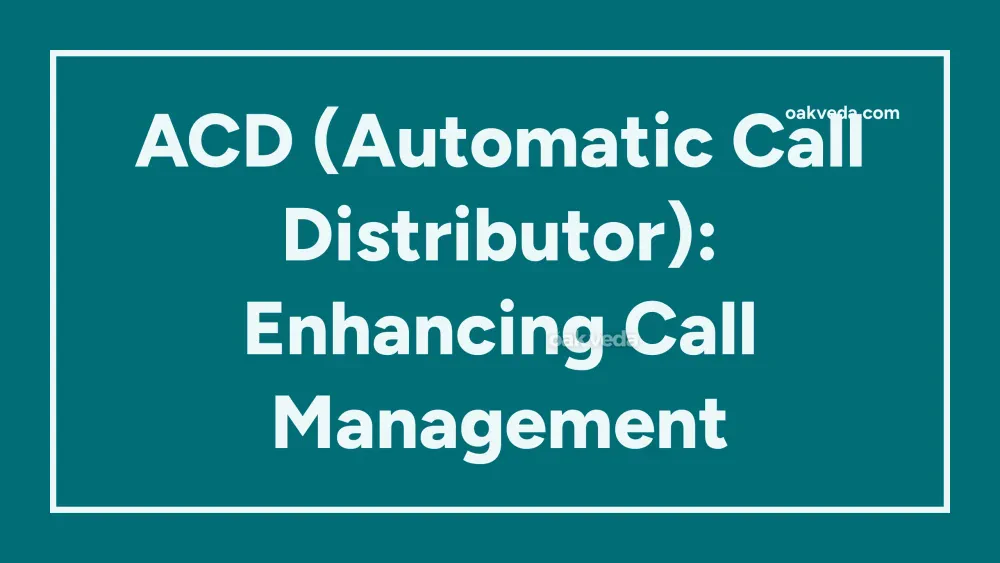
Understanding ACD: The Full Form and Its Significance
ACD, with its full form being Automatic Call Distributor, is a crucial technology in modern telecommunications. This sophisticated system plays a pivotal role in managing and routing incoming calls efficiently within call centers and customer service departments.
The Evolution of ACD Technology
Automatic Call Distributors have come a long way since their inception. Initially developed to handle large volumes of incoming calls, ACDs have evolved to become intelligent systems capable of complex call routing based on various parameters.
Key Milestones in ACD Development:
- 1970s: Introduction of basic ACD systems
- 1980s: Integration with computer systems
- 1990s: Incorporation of skills-based routing
- 2000s: Cloud-based ACD solutions emerge
- Present: AI-powered ACDs with predictive capabilities
How Automatic Call Distributors Work
ACDs operate by analyzing incoming calls and directing them to the most appropriate agent or department. This process involves several steps:
- Call detection and answering
- Caller information gathering
- Rule-based routing decision
- Queue management
- Call distribution to available agents
Modern ACDs utilize advanced algorithms and artificial intelligence to make split-second decisions, ensuring optimal call handling and minimizing wait times.
Types of ACD Distribution Methods
Automatic Call Distributors employ various distribution methods to allocate calls effectively:
Linear Call Distribution
This method distributes calls sequentially, starting from the first available agent in the list.
Circular or Rotary Call Distribution
Calls are distributed in a loop, ensuring a more balanced workload among agents.
Uniform Call Distribution
This approach aims to distribute calls evenly by routing to the agent who has handled the least number of calls.
Simultaneous Call Distribution
All available agents receive the call notification simultaneously, with the first to respond handling the call.
Weighted Call Distribution
Calls are allocated based on predefined weights, often reflecting agent skills or experience levels.
Applications of ACD in Various Industries
The versatility of Automatic Call Distributors makes them invaluable across numerous sectors:
-
Customer Service Centers: ACDs streamline customer support operations, reducing wait times and improving satisfaction.
-
Healthcare: Hospitals and clinics use ACDs to manage patient inquiries and route calls to appropriate departments.
-
Financial Services: Banks and insurance companies utilize ACDs to handle high call volumes and direct customers to specialized agents.
-
Retail: E-commerce businesses employ ACDs to manage customer queries, order status checks, and returns.
-
Government Services: Public sector organizations use ACDs to efficiently manage citizen inquiries and route calls to relevant departments.
Integration with CTI and CSTA
Automatic Call Distributors often work in tandem with Computer Telephony Integration (CTI) and Computer-Supported Telecommunications Applications (CSTA). This integration enhances functionality by:
- Providing agents with caller information through screen pops
- Enabling advanced routing based on customer data
- Facilitating seamless omnichannel communication
The Role of ACDs in Virtual Contact Centers
As businesses increasingly adopt remote work models, ACDs play a crucial role in virtual contact centers:
- Enabling geographically dispersed agents to handle calls seamlessly
- Facilitating real-time data sharing between multiple contact center locations
- Supporting skills-based routing across a distributed workforce
Future Trends in ACD Technology
The landscape of Automatic Call Distributors continues to evolve, with several emerging trends:
-
AI-Powered Routing: Machine learning algorithms optimizing call distribution based on historical data and real-time factors.
-
Omnichannel Integration: ACDs expanding to manage interactions across various channels, including chat, email, and social media.
-
Cloud-Based Solutions: Increased adoption of cloud ACDs for scalability and flexibility.
-
Advanced Analytics: Enhanced reporting and analytics capabilities for better decision-making and performance optimization.
-
Voice Biometrics: Integration of voice recognition technology for improved security and personalized service.
Conclusion
Automatic Call Distributors, or ACDs, have become indispensable tools in modern customer service operations. By efficiently managing and routing incoming calls, ACDs help businesses provide superior customer experiences while optimizing resource utilization. As technology continues to advance, the full potential of ACDs in reshaping customer interactions is yet to be fully realized.
You may be interested in:

